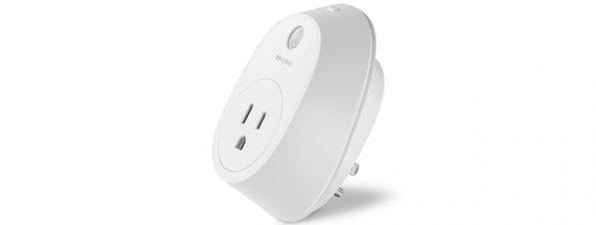
Smart plugs can offer many useful features like remote management, real-time statistics of your energy consumption, tools that simulate you being at home when you are not, and so on. However, they tend to be a lot more expensive than their "dumb" counterparts. If you want to use a smart plug that it is also affordable, then you should look at TP-LINK HS100. Its price is lower than other similar devices, and it delivers some useful features. Read this review to see our opinion about this device and whether it fits your needs:
What is the TP-LINK HS100 smart Wi-Fi plug good at?
TP-LINK HS100 smart Wi-Fi plug is an affordable smart home device that allows you to save energy, remote control your devices when you are traveling, and set up sequences of actions that are useful in several situations, including when you are away from home, and you want it to appear that you are home.
Pros and cons
The TP-LINK HS100 smart Wi-Fi plug has several positives:
- It's small and light
- It's easy to use and setup
- You can remote control the smart plug even when you are not at home, from your smartphone
- You can use it to save energy and lower your electricity bill
-
It offers useful features like Away mode or the schedule for its operation
- It is integrated with Amazon Alexa and Google Assistant
There are also some negatives to consider, some of which are important:
- This smart plug doesn't offer energy monitoring reports
- There's no app for Windows and no website for remote controlling the TP-LINK HS110, only a smartphone app
-
TP-LINK's cloud-based ecosystem lacks security features like two-step verification. Also, there's no PIN or fingerprint protection for the Kasa for Mobile app.
- The Android mobile app should require access to less information
- The timer, the scheduler, and the away mode can conflict with each other if you are not careful how you set them up
Verdict
The TP-LINK HS100 smart Wi-Fi plug is the most affordable device of its kind from TP-LINK's portfolio. It works well, it is easy to set up and use, and it delivers everything that it promises. However, being the more affordable model, it offers fewer "smart" features than TP-LINK HS110, the biggest downside being that you don't get real-time energy monitoring and reporting. Also, the approach TP-LINK has taken regarding security, needs some improvements. If you don't mind these minuses, TP-LINK HS100 is a perfect starting choice for those of you who want a smarter plug, at an affordable price.
Unboxing the TP-LINK HS100 smart Wi-Fi plug
The TP-LINK HS100 smart Wi-Fi plug comes in a small white box, featuring a picture of the device on the top, alongside its name and the company logo.
On the sides of the box, you get a presentation of this smart plug's best features and some instructions on how to set it up. When you open the box, you see the smart plug, the quick start guide, technical support information, a leaflet about the Kasa mobile app that is used to control the smart plug, and the warranty.
The unboxing experience is quick and pleasant. There are no accessories bundled with the smart plug.
Hardware specifications and design
The TP-LINK HS100 smart Wi-Fi plug can work only with the 802.11 b/g/n networking standards. We wish it also offered 802.11ac wireless connectivity.
It can work well in temperatures varying from 32°F or 0ºC to 104°F or 40ºC, and a relative humidity between 5%~90%, making it suitable for many homes and offices. Regarding size, the plug is quite small, with 3.9 x 2.6 x 2.5 inches or 100.3 x 66.3 x 64 millimeters in height, width and depth. The total weight is only 4.34 ounces or 123.3 grams. If you look at these specs, they are identical to its bigger brother: TP-LINK HS110.
The TP-LINK HS100 smart plug has two buttons: one on the top for resetting it to its default configuration and the second button on the front. This one has a WiFi icon, which displays the connectivity, and an On/Off icon. You press it to turn whatever's plugged into it On and Off.
The TP-LINK HS100 smart plug can be fully utilized only if you have a smartphone with Android or iOS. It can't be configured from devices with Windows, and there's no way to configure it from the web, even if you connect it to the TP-LINK cloud, from your smartphone. You must install the Kasa for Mobile app, made by TP-LINK, which works with Android 4.1 or higher and iOS 8 or newer.
After you configure the smart plug on your smartphone, you can schedule the working hours of the TP-LINK HS100, and set the away mode, which simulates that someone is home while you are away from home. You can also control the smart plug with your voice, using Amazon Echo (if you have such a device at home) or Google Assistant.
To learn more about the official specifications of this device, go to this page: TP-LINK HS100 Specifications.
Setting up and using the TP-LINK HS100 smart Wi-Fi plug
Take the TP-LINK HS100 smart Wi-Fi plug and plug it into the electrical outlet where you want to use it. Then, connect the device(s) that you want to control with the smart plug. To utilize the smart plug, on your smartphone install the Kasa for Mobile app for Android or iOS. If you don't install the Kasa app, TP-LINK HS100 will act like any other "dumb" plug.
Unfortunately, the Kasa for Mobile app requires access to many things, starting with your location, your files, wireless connection information as well as device ID and call information. This is quite a lot in our view, and the app should require less access.
Then, you must create an account on the TP-LINK cloud, to remote control the smart plug. After verifying your account, you can configure all your smart TP-LINK devices, including the smart plug.
Once the Kasa for Mobile app detects the TP-LINK HS100 smart plug, you can set a name for it, an icon, and join it to your wireless network. After all these steps are done, you can see the status of the smart plug and activate and configure its features.
The user interface of the app is straightforward and easy to use. However, it is only available in English. You can use the mobile app to view the runtime of the smart plug, set its schedule, away mode and the timer. You can also change its default settings.
Unlike the more expensive TP-LINK HS110 smart plug, you don't get real-time statistics about the power that it is used by the device which is plugged into your smart plug. Also, you don't see its total consumption, just runtime statistics. For us, this missing feature diminished the appeal of TP-LINK HS100, as we wanted to see this information.
Unfortunately, there are conflicts between the available modes. For example, the timer allows you to turn the smart plug on or off after a specified time, and it will override the Away mode until the timer has been completed. Also, if there's a conflict between the schedule and timer, the smart plug will run based on whichever starts earlier. Therefore, when setting these features, make sure that they don't conflict with each other. Otherwise, you might get errors or unwanted results.
When using the Kasa for Mobile app, we had no issues in configuring all the available settings.
There aren't many, and they are easy to change. We also made successful firmware updates with ease. Any user should be able to pull this off, without any specialized technical knowledge.
While the TP-LINK HS100 smart plug is a good little device in itself, we do have some criticism of TP-LINK's cloud-based ecosystem: the Kasa for Mobile app connects to TP-LINK's cloud and sends data to it, to offer remote control for all your smart home devices. However, if you open TP-LINK Cloud website and authenticate with your account, there's nothing useful to be found. You are told that no camera exists in your account, and that's it. You should be able to view and manage all your smart home devices on their website too. Also, the security of TP-LINK's cloud is weak, and it doesn't have two-factor verification. Another issue is that Kasa for Mobile doesn't have an access PIN, fingerprint authentication or some other form of protection. If someone else gets their hands on your smartphone, they can easily control your smart home devices, including the TP-LINK HS100 smart plug.
Another minor negative about the TP-LINK HS100 smart plug is that you can't dim its light during the night, which might be annoying to some users. It would have been nice to have this feature available for configuration, at least in the mobile app, if not a physical button for turning the lights off.
The TP-LINK HS100 smart plug works well and delivers everything that it promises in the official specifications. Also, it is easy to configure and use for anyone, whether they are a beginner or an expert. However, there are some weaknesses regarding security and the fact that it doesn't offer real-time statistics about the power that it is used, limits its appeal when compared to TP-LINK HS110.
What is your opinion about the TP-LINK HS100 smart Wi-Fi plug?
Now that you know our verdict about the TP-LINK HS100 smart Wi-Fi plug and how it compares with its more expensive brother - TP-LINK HS110 let us know what you think. Is it useful to you? Do you want more features? If you have used this smart plug, what was your experience with it? Feel free to comment below.


 05.09.2017
05.09.2017 











